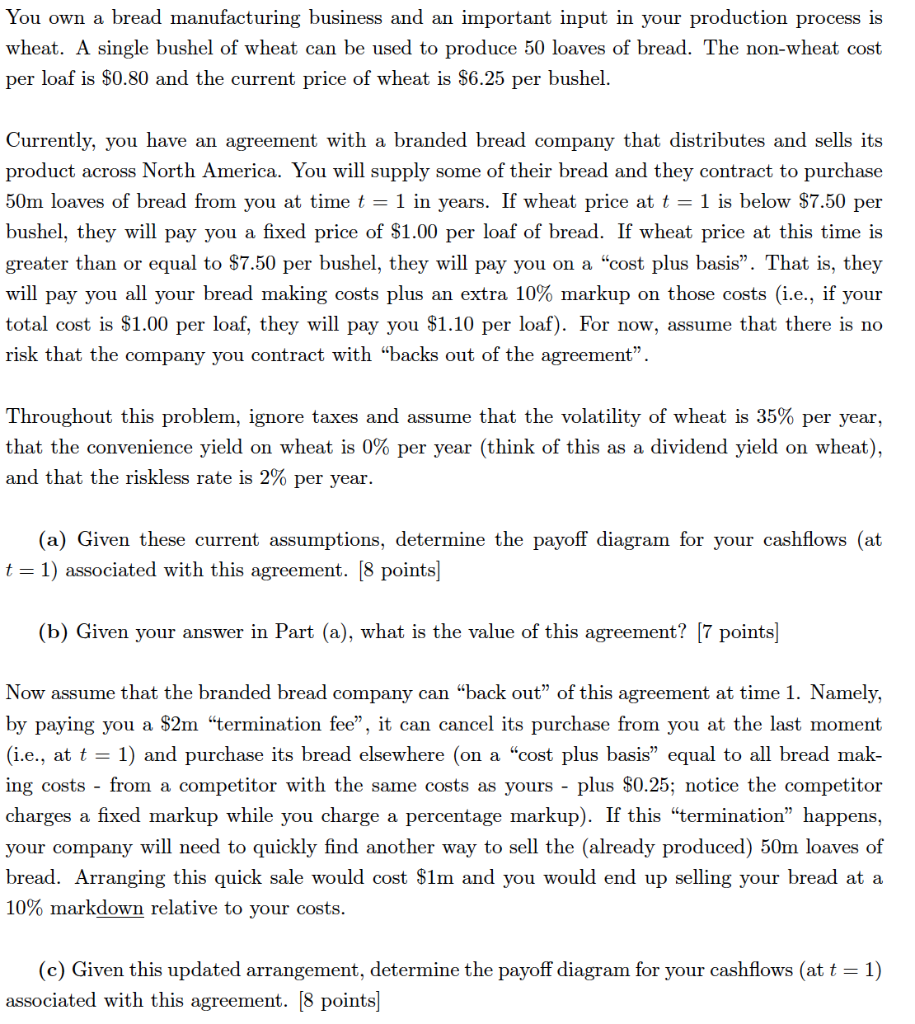PLS HELP!

You own a bread manufacturing business and an important input in your production process is wheat. A single bushel of wheat can be used to produce 50 loaves of bread. The non-wheat cost per loaf is $0.80 and the current price of wheat is $6.25 per bushel. Currently, you have an agreement with a branded bread company that distributes and sells its product across North America. You will supply some of their bread and they contract to purchase 50m loaves of bread from you at time t = 1 in years. If wheat price at t = 1 is below $7.50 per bushel, they will pay you a fixed price of $1.00 per loaf of bread. If wheat price at this time is greater than or equal to $7.50 per bushel, they will pay you on a cost plus basis. That is, they will pay you all your bread making costs plus an extra 10% markup on those costs (i.e., if your total cost is $1.00 per loaf, they will pay you $1.10 per loaf). For now, assume that there is no risk that the company you contract with backs out of the agreement. Throughout this problem, ignore taxes and assume that the volatility of wheat is 35% per year, that the convenience yield on wheat is 0% per year (think of this as a dividend yield on wheat), and that the riskless rate is 2% per year. (a) Given these current assumptions, determine the payoff diagram for your cashflows (at t = 1) associated with this agreement. [8 points) (b) Given your answer in Part (a), what is the value of this agreement? [7 points] Now assume that the branded bread company can back out of this agreement at time 1. Namely, by paying you a $2m termination fee, it can cancel its purchase from you at the last moment (i.e., at t = 1) and purchase its bread elsewhere (on a cost plus basis equal to all bread mak- ing costs - from a competitor with the same costs as yours - plus $0.25; notice the competitor charges a fixed markup while you charge a percentage markup). If this termination happens, your company will need to quickly find another way to sell the (already produced) 50m loaves of bread. Arranging this quick sale would cost $1m and you would end up selling your bread at a 10% markdown relative to your costs. (c) Given this updated arrangement, determine the payoff diagram for your cashflows (at t = 1) associated with this agreement. [8 points] You own a bread manufacturing business and an important input in your production process is wheat. A single bushel of wheat can be used to produce 50 loaves of bread. The non-wheat cost per loaf is $0.80 and the current price of wheat is $6.25 per bushel. Currently, you have an agreement with a branded bread company that distributes and sells its product across North America. You will supply some of their bread and they contract to purchase 50m loaves of bread from you at time t = 1 in years. If wheat price at t = 1 is below $7.50 per bushel, they will pay you a fixed price of $1.00 per loaf of bread. If wheat price at this time is greater than or equal to $7.50 per bushel, they will pay you on a cost plus basis. That is, they will pay you all your bread making costs plus an extra 10% markup on those costs (i.e., if your total cost is $1.00 per loaf, they will pay you $1.10 per loaf). For now, assume that there is no risk that the company you contract with backs out of the agreement. Throughout this problem, ignore taxes and assume that the volatility of wheat is 35% per year, that the convenience yield on wheat is 0% per year (think of this as a dividend yield on wheat), and that the riskless rate is 2% per year. (a) Given these current assumptions, determine the payoff diagram for your cashflows (at t = 1) associated with this agreement. [8 points) (b) Given your answer in Part (a), what is the value of this agreement? [7 points] Now assume that the branded bread company can back out of this agreement at time 1. Namely, by paying you a $2m termination fee, it can cancel its purchase from you at the last moment (i.e., at t = 1) and purchase its bread elsewhere (on a cost plus basis equal to all bread mak- ing costs - from a competitor with the same costs as yours - plus $0.25; notice the competitor charges a fixed markup while you charge a percentage markup). If this termination happens, your company will need to quickly find another way to sell the (already produced) 50m loaves of bread. Arranging this quick sale would cost $1m and you would end up selling your bread at a 10% markdown relative to your costs. (c) Given this updated arrangement, determine the payoff diagram for your cashflows (at t = 1) associated with this agreement. [8 points]







